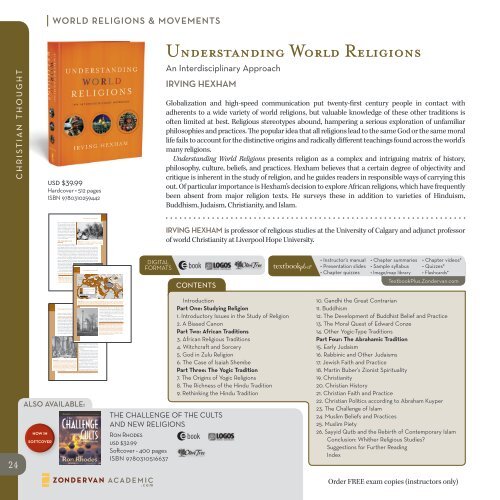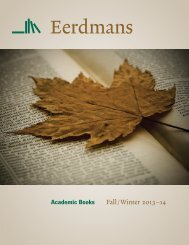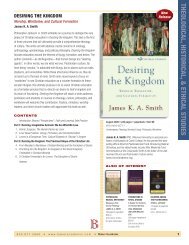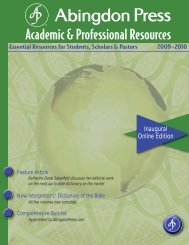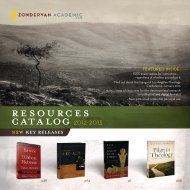koinonia
new releases
new releases
Create successful ePaper yourself
Turn your PDF publications into a flip-book with our unique Google optimized e-Paper software.
causes. The majority of contemporary<br />
Africans and people living in traditional<br />
societies still tend to be more concerned<br />
with the uniqueness of things and to<br />
think in terms of personal causes. When<br />
Britons, during World War II, thought<br />
that they would be hit by a bomb only<br />
if it “had my name on it,” they were<br />
adopting very much the same attitude.<br />
“It won’t happen to me. I’m different” is<br />
a fairly common way of expressing the<br />
converse of this attitude.<br />
Photo 4.7 As the healing ritual progresses, notice the involvement<br />
of the sick woman’s companion. African healing is<br />
In the early 1960s Fred Welbourn both a personal and a communal affair.<br />
observed a young Muganda (a member<br />
of the Buganda people of southern Uganda) who was awarded a university scholarship to<br />
study in Britain. On his way to the airport at the start of his journey, he suddenly went<br />
blind and his head began to ache terribly. He was taken home and consulted a diviner. He<br />
was told that he had been chosen by a spirit to be its medium and that unless he accepted the<br />
choice he might go mad. Many Africans — though not always so highly educated — have<br />
had similar experiences; and in Buganda their initiation takes some such form as follows.<br />
On the appointed night, the young man and his relatives went to the shrine of a<br />
diviner, where a fire was kept burning throughout the rite. They were washed with water<br />
from Lake Victoria, and the juice of leaves was smeared on their heads. They were given<br />
branches and spears to hold. The diviner’s assistants started to beat drums in a peculiar<br />
rhythm, shake rattles, and sing special spirit songs. After this had been going on for some<br />
time, the initiate started to shake.<br />
The drumming and singing grew<br />
wilder. The shaking affected him<br />
more and more violently until he<br />
rose and started to dance wildly.<br />
The drumming and singing 438 The AbrAmic TrAdiTion<br />
became more and more excited.<br />
He danced in the fire, apparently<br />
London<br />
Photo 4.8 A healing dance in the<br />
ATLANTIC<br />
surgery of Estelle Nxele. Her consulting<br />
room was in her home, but for<br />
OCEAN<br />
Black Sea<br />
Aral<br />
Vienna<br />
rituals and dance she often used her<br />
Constantinople<br />
Rome<br />
Sea<br />
garage, pictured right, as a surgery.<br />
Mediterranean Sea<br />
Delhi<br />
Ottoman Empire at its height<br />
Mughal Empire at its height<br />
Arabian<br />
0310259442_understanding_int_CS4 brown 1-248.indd 73<br />
2/1/11 11:37 AM<br />
Safavid Empire<br />
Sea<br />
Bay of<br />
GOA<br />
Bengal<br />
0 1000 km.<br />
0 1000 miles<br />
INDIAN OCEAN<br />
Map 24.3 Islamic empires of the seventeenth and eighteenth centuries. At this time the British Empire was<br />
just emerging as a network of trading companies, and there were no other European or “Chris tian” empires to<br />
challenge Islam. Further, in the Far East the Chinese Empire was weak. Islam was at its height in terms of world<br />
dominance, and was therefore feared in Europe and other non-Muslim areas.<br />
the will of God. Thus it is a Pax Islamica, which<br />
276 The AbrAmic TrAdiTion<br />
imposes peace by dominating all opponents by force<br />
or arms. At the same time, areas remaining free from<br />
control by Muslim rulers are viewed as the “realm<br />
of war,” awaiting subjection to Islamic rule and the<br />
administration of Sharia law.<br />
This is why Muslims throughout history have<br />
regarded “the Conquests” of the first century of the<br />
From the early Middle Ages, Jews migrated through Germany and areas of the Byzantine<br />
Muslim era as the second great miracle of Islam, after<br />
Empire into Russia and Poland. In 1264, Prince Boleslav V (1226 – 1279), Duke of Krakow,<br />
granted the Jews a charter guaranteeing their legal rights and protection. A century<br />
the reception of the Qur’an. Islam proclaims submislater,<br />
during the rule of King Casimir III (1310 – 1370), a series of decrees extended rights<br />
to Jews throughout Poland. Then, in 1388, the Grand Duke of Lithuania welcomed the Photo 24.14 The Wilmersdorfer Mosque, in Berlin, Germany,<br />
reminds viewers that, while in the past Islam was of-<br />
Jews to his lands. These developments, though good for Jewish immigrants, providing<br />
ten spread as a result of military victories, thus justifying a<br />
them with considerable protection under the law, had a dark side which appears to have<br />
military understanding of jihad, today Islam is rapidly spreading<br />
throughout Europe and other parts of the world through<br />
affected the fate of the Jews in modern times. As earlier in Spain, the Jews, an educated<br />
people, provided reliable and able recruits for government ser vice. As a result many became immigration and conversion without coercion. As a result, it<br />
tax collectors, estate managers, and agents of the government, and they were feared by now presents a far greater intellectual challenge to Chris tianity<br />
and other religions than when it was possible to explain<br />
the common people, who saw them as oppressors. To make matters worse, as in Spain,<br />
they were required to wear their own distinctive<br />
clothing. Therefore, no one could<br />
away its success in terms of conquest.<br />
fail to know that the hated tax collector or<br />
government bailiff was a Jew. Undoubtedly<br />
these developments laid a foundation<br />
for later anti-Semitism. By the early fifteenth<br />
century there were around 15,000<br />
0310259442_understanding_int_CS4 Jews in Poland. brown A 249-512.indd century 438later that<br />
number had grown to around 150,000 as<br />
Poland became a center of Jewish life and<br />
scholarship.<br />
Jewish prosperity in Polish areas came<br />
to a dramatic end in the seventeenth century,<br />
when Ukrainian Cossacks revolted<br />
against their Polish masters and massacred<br />
Jews and Polish landowners alike. In what<br />
became a major peasant revolt, Polish gentry<br />
and their Jewish administrators were<br />
Photo 16.5 This woodcut shows Sabbatai Zevi (1626 – 1676) slaughtered in gruesome ways.<br />
in a Turkish prison. He declared himself the Messiah in 1648 Eventually the rule of the Cossacks<br />
and was eventually imprisoned in Constantinople, where, in<br />
led to the separation of Poland and the<br />
the castle of Abydos, he converted to Islam on 16 September<br />
1666. Later he vacillated between Judaism and Islam. Ukraine as well as intervention by the<br />
His followers, known as Sabbateans, drew inspiration from Russian and Swedish armies. The involvement<br />
of foreign troops gave birth to a Pol-<br />
Jewish mysticism, especially the kabbalah, and are believed<br />
to have influenced the development of the Hassidic movement<br />
in Poland and elsewhere.<br />
ish partisan movement that resisted both<br />
the Russians and the Swedes. In the pro-<br />
10. Dan Cohn-Sherbok, Judaism: History, Belief and Practice (London: Routledge, 2003), 210 – 19.<br />
0310259442_understanding_int_CS4 brown 249-512.indd 276<br />
WitcHcraft and sorcery 73<br />
2/1/11 11:50 AM<br />
R.<br />
2/1/11 11:51 AM<br />
world religions & movements<br />
christian thought<br />
usd $39.99<br />
Hardcover • 512 pages<br />
ISBN 9780310259442<br />
Understanding World Religions<br />
An Interdisciplinary Approach<br />
Irving hexham<br />
Globalization and high-speed communication put twenty-first century people in contact with<br />
adherents to a wide variety of world religions, but valuable knowledge of these other traditions is<br />
often limited at best. Religious stereotypes abound, hampering a serious exploration of unfamiliar<br />
philosophies and practices. The popular idea that all religions lead to the same God or the same moral<br />
life fails to account for the distinctive origins and radically different teachings found across the world’s<br />
many religions.<br />
Understanding World Religions presents religion as a complex and intriguing matrix of history,<br />
philosophy, culture, beliefs, and practices. Hexham believes that a certain degree of objectivity and<br />
critique is inherent in the study of religion, and he guides readers in responsible ways of carrying this<br />
out. Of particular importance is Hexham’s decision to explore African religions, which have frequently<br />
been absent from major religion texts. He surveys these in addition to varieties of Hinduism,<br />
Buddhism, Judaism, Christianity, and Islam.<br />
24<br />
the “cAlling” of A<br />
diVineR<br />
#11 Eastern_Hemisphere<br />
Danube R.<br />
number converted to Islam. For the next few centuries, Jews generally flourished in the<br />
Ottoman, or Turkish, Empire. 10<br />
northern euroPean Jews<br />
also available:<br />
Islamic Empires in 17th Century (map 24-3) 100%<br />
Nile R.<br />
Red Sea<br />
Sea<br />
Caspian<br />
OTTOMAN<br />
EMPIRE<br />
SAFAVID<br />
EMPIRE<br />
MUGHAL<br />
EMPIRE<br />
Persian Gulf<br />
Indus<br />
DIGITAL<br />
FORMATS<br />
irving hexham is professor of religious studies at the University of Calgary and adjunct professor<br />
of world Christianity at Liverpool Hope University.<br />
book<br />
Contents<br />
THE Challenge of the cults<br />
and new religions<br />
Ron Rhodes<br />
book<br />
usd $32.99<br />
Softcover • 400 pages<br />
ISBN 9780310516637<br />
Introduction<br />
Part One: Studying Religion<br />
1. Introductory Issues in the Study of Religion<br />
2. A Biased Canon<br />
Part Two: African Traditions<br />
3. African Religious Traditions<br />
4. Witchcraft and Sorcery<br />
5. God in Zulu Religion<br />
6. The Case of Isaiah Shembe<br />
Part Three: The Yogic Tradition<br />
7. The Origins of Yogic Religions<br />
8. The Richness of the Hindu Tradition<br />
9. Rethinking the Hindu Tradition<br />
• Instructor’s manual • Chapter summaries • Chapter videos*<br />
• Presentation slides • Sample syllabus • Quizzes*<br />
• Chapter quizzes • Image/map library • Flashcards*<br />
TextbookPlus.Zondervan.com<br />
10. Gandhi the Great Contrarian<br />
11. Buddhism<br />
12. The Development of Buddhist Belief and Practice<br />
13. The Moral Quest of Edward Conze<br />
14. Other Yogic-Type Traditions<br />
Part Four: The Abrahamic Tradition<br />
15. Early Judaism<br />
16. Rabbinic and Other Judaisms<br />
17. Jewish Faith and Practice<br />
18. Martin Buber’s Zionist Spirituality<br />
19. Christianity<br />
20. Christian History<br />
21. Christian Faith and Practice<br />
22. Christian Politics according to Abraham Kuyper<br />
23. The Challenge of Islam<br />
24. Muslim Beliefs and Practices<br />
25. Muslim Piety<br />
26. Sayyid Qutb and the Rebirth of Contemporary Islam<br />
Conclusion: Whither Religious Studies?<br />
Suggestions for Further Reading<br />
Index<br />
Order FREE exam copies (instructors only)


